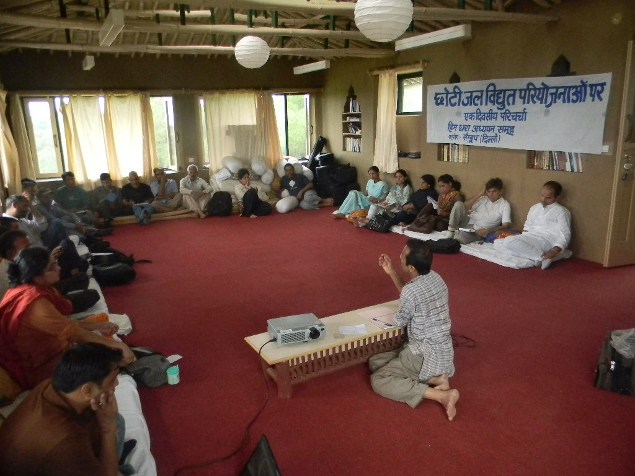9th September 2012 at Sambhaavnaa Institute, Palampur
Himachal Pradesh, like Uttarakhand and other North-Eastern hill states for the past decade, now has been viewed as the ‘power state’ with hydro power potential to the tune of approximately 21,000 MW. The pressure is not just to make power, but make ‘clean’ power, using the run-off river technology, propagated as less damaging, socially and environmentally But our experience from the ground and local protests in several area across Himachal has indicated that these projects, involving diversion of rivers and streams, are damaging local livelihoods, and leading to the destruction of forests in different ways, even if direct displacement is minimal.
While the large and medium Hydel Power projects have been in the line of fire for their environmental impacts, the small hydro-electric projects (SHEPs) of less than 5 MW capacity seem to have escaped the lens. Of the 21000, 750 MW potential is being looked at under the small hydro sector—run off the river projects, promoted as eco-friendly, renewable energy, cost effective and decentralised structures. The Himachal government has taken several initiatives to encourage private sector participation in small hydro-power development. Attractive incentives for independent power producers, in the form of easy land acquisition procedures and speedy clearances are being ensured now.
What has been overlooked is that small projects are coming up on the smaller streams which sustain local livelihoods of remotely located poor communities and fragile but bio-diverse ecosystems in numerous ways. In Kangra, these streams support the traditional irrigation channels or kuhls. Watermills are run on these and in many places they even supply drinking water to villages. Since these are small projects, no environmental clearance from the Ministry of Environment and Forests is required. The critical clearances that are required at the state level include the techno-economic clearanceand those from the Irrigation and Public Health (IPH) Department, Fisheries Department and Public Works Department. But there are no mechanisms in place at the state level to ensure a cost benefit analysis with an environment and social impact assessment of small hydel projects, neither are NoCs from Gram Panchayats mandatory. Accountability mechanisms are completely absent. The recent news that as many as 23 power projects in Kangra district have been found to have encroached upon government and forest land is an indication of this.
Involvement of private entrepreneurs in these projects, looking for incentives, quick and easy profits, has further enraged the local populations—who do not stand to gain much in these investments. On the other hand, many of these are going in for the clean development mechanism under which they gain large subsidies for saving carbon emission in energy generation. While the total cost of setting up a 1 MW Project stands at around Rs 4 to 7 crores, the returns are massive at around Rs 60,000 a day for a single MW. If we take into account the subsidies the profit margins are huge.
In the above context, Himdhara with support from SANDRP and Sambhaavnaa organised a dialogue with and amongst communities affected by Small Hydropower Projects and trying to assert their rights on a crucial natural resource – their river and water. The one day meeting was organised at Sambhaavnaa Institute Palampur, Kangra with the objectives of:
– Building an understanding of the impacts that SHEPs are having on local livelihoods, environment and water rights
– Building capcities of local community activists/representatives by linking them with other affected people/activists and organisations working on the issue and providing relavant policy information
– Brainstorming on strategies to raise these issues with the government and concerned authorities







6 thoughts on “Small Hydropower, Big Impact? A discussion on issues facing local communities in Himachal Pradesh”
Small Hydro, MNRE and environmental impacts: Nero’s fiddle playing | SANDRP
(October 28, 2013 - 5:45 am)[…] Himdhara’s Report on Mini Hydel Projects in Uttarakhad: http://www.himdhara.org/2012/09/09/small-hydropower-big-impact-a-discussion-on-issues-facing-local-c… […]
Address Impacts of Small Hydel Projects | SANDRP
(November 11, 2013 - 5:36 am)[…] Þ Himdhara’s Report on Mini Hydel Projects in Himachal Pradesh: http://www.himdhara.org/2012/09/09/small-hydropower-big-impact-a-discussion-on-issues-facing-local-c… […]
Run Into The River | Himdhara
(March 24, 2014 - 6:20 am)[…] i) http://www.himdhara.org/2012/09/09/small-hydropower-big-impact-a-discussion-on-issues-facing-local-c… […]
Run into the River | waterlandair
(March 28, 2014 - 2:43 pm)[…] http://www.himdhara.org/2012/09/09/small-hydropower-big-impact-a-discussion-on-issues-facing-local-c… […]
Small hydels: Are they really clean, green and safe? | Kractivism
(August 6, 2014 - 11:33 am)[…] [1] Small Hydropower, Big Impact? […]
Draft Mission on Small Hydro Projects: Encouraging investment, ignoring impacts | SANDRP
(February 16, 2015 - 5:33 am)[…] [15] See detailed reports here: https://sandrp.wordpress.com/2014/06/08/the-socio-ecological-effects-of-small-hydropower-development-in-himachal-pradesh/, https://sandrp.wordpress.com/2014/06/11/the-socio-ecological-impacts-of-small-hydropower-projects-in-himachal-pradesh-part-2/, http://www.himdhara.org/2012/09/09/small-hydropower-big-impact-a-discussion-on-issues-facing-local-c… […]
Comments are closed.